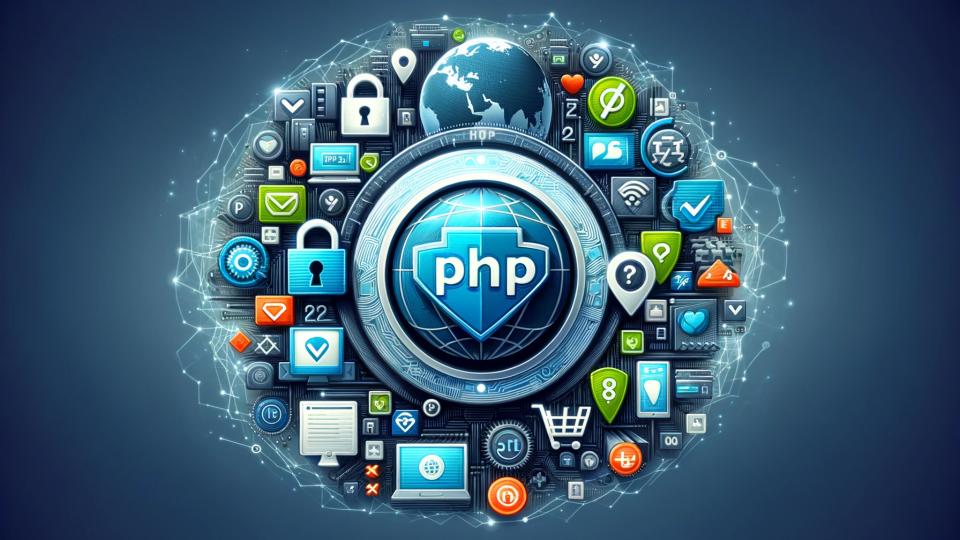E-commerce has rapidly evolved into a cornerstone of the modern economy, and the technology powering online retail platforms is crucial for their success. PHP, an acronym for “Hypertext Preprocessor,” stands out as a preferred choice for developing e-commerce websites. Its popularity stems from its simplicity, flexibility, and robust features, making it an ideal tool for creating dynamic and interactive online shopping experiences.
PHP is known for its ease of use. It is both simple to learn, especially for those already familiar with programming languages like C or Java, and straightforward in application, allowing developers to construct impactful websites with interactive user interfaces efficiently. This accessibility is a significant factor in its widespread adoption.
The adaptability of PHP is another highlight. It is compatible with all major web browsers and operating systems. This cross-platform compatibility ensures that e-commerce websites built with PHP can reach a broad audience without compatibility issues. Additionally, PHP’s integration with HTML makes it a powerful tool for crafting e-commerce websites that are both functional and visually appealing.
Security is a paramount concern in the e-commerce domain, and PHP addresses this with robust features. Despite being an open-source language, PHP offers a level of security on par with other advanced programming languages. This capability is critical in protecting websites and their users from cybersecurity threats.
Another reason behind PHP’s popularity in the e-commerce sector is its large developer community. The presence of a vast pool of PHP developers means an abundance of resources, including frameworks, libraries, and tools, which are essential in streamlining the development process. This community also offers extensive support through forums, tutorials, and documentation, easing the learning curve for new developers and ensuring best practices in PHP development.
PHP emerges as a versatile, user-friendly, and secure choice for e-commerce website development. Its compatibility with various technologies, ease of learning, and strong community support make it an ideal solution for businesses looking to establish or enhance their online retail presence.
Why Choose PHP for E-commerce Development?
PHP has cemented its position as a key player in the realm of e-commerce website development. Its selection by developers and businesses is not arbitrary but driven by several compelling factors that cater to the diverse and dynamic needs of online retail platforms.
Ease of Learning and Accessibility:
One of PHP’s standout features is its relative simplicity, making it accessible to a broad range of developers. This ease of learning is particularly beneficial for those with a background in languages like C or Java. PHP’s syntax is straightforward, which enables quick adaptation and proficiency. This accessibility leads to a wider pool of developers who can contribute to building and maintaining e-commerce platforms, reducing the need for extensive training and allowing for quicker development cycles.
Vibrant Developer Community:
The strength of PHP also lies in its large and active developer community. This community is a treasure trove of shared knowledge, resources, and support. From frameworks and libraries to tools and best practices, the PHP community actively contributes to a rich ecosystem that supports e-commerce development. This communal support is invaluable for troubleshooting, learning, and staying updated with the latest trends and technologies in PHP e-commerce development.
Integration with Other Technologies:
PHP’s versatility extends to its seamless integration with various technologies. This includes a range of databases, web servers, and content management systems, making PHP a flexible choice for e-commerce sites that require integration with other systems. For instance, PHP’s compatibility with MySQL enables the development of robust e-commerce platforms with powerful backend databases. Moreover, PHP’s integration with popular content management systems like WordPress simplifies the creation and management of e-commerce sites using familiar interfaces.
Customizability for Unique Business Needs:
Customizability is another hallmark of PHP, allowing developers to tailor e-commerce websites to specific business requirements. This includes the creation of custom themes, plugins, and extensions, especially when using frameworks like Magento or WooCommerce. Such customizability ensures that businesses can build e-commerce platforms that not only align with their branding but also offer personalized experiences to their customers.
High Performance and Scalability:
Performance is critical for e-commerce websites, and PHP excels in this area. PHP-based websites can handle high traffic and transaction volumes efficiently. Developers can employ various optimization techniques, such as caching and using content delivery networks (CDNs), to further enhance performance. This ensures that e-commerce platforms can provide smooth and seamless user experiences, even under heavy load conditions.
PHP offers a combination of user-friendliness, community support, integration flexibility, customizability, and high performance, making it an ideal choice for developing e-commerce websites. These attributes align well with the needs of modern online retail platforms, where reliability, scalability, and user experience are paramount.
Key Features of PHP in E-commerce

PHP’s role in e-commerce extends beyond just a programming language; it’s a comprehensive solution that offers a range of features tailored for online retail platforms. These features not only enhance the functionality of e-commerce sites but also provide a secure, efficient, and user-friendly shopping experience.
Cloud Compatibility
One of the standout features of PHP in e-commerce is its compatibility with cloud services. In the age of digital transformation, where cloud computing plays a pivotal role, PHP’s alignment with cloud technologies like AWS Lambda ensures scalability and modernization without the need to switch programming languages. This compatibility is crucial for businesses aiming to leverage the cloud’s advantages, such as scalability, reliability, and advanced functionalities.
Enhanced Security
Security is a top priority in e-commerce, where transactions and personal data are involved. PHP, despite being open-source, offers robust security features. These features are critical in safeguarding websites and their users from cyber threats, making PHP a reliable choice for e-commerce platforms where data protection is vital.
Accelerated Mobile Pages (AMP)
In today’s mobile-first world, the speed of mobile pages is paramount. PHP supports Accelerated Mobile Pages (AMP), an open-source initiative designed to optimize mobile page performance. This ensures fast-loading mobile pages, enhancing the user experience and potentially leading to higher conversion rates.
Internet of Things (IoT) Integration
The integration of PHP with IoT technologies represents a forward-thinking approach in e-commerce development. PHP’s dynamic nature makes it suitable for IoT device communication, opening up possibilities for innovative features in online shopping, like smart product recommendations and enhanced customer interaction.
Superior User Interface (UI)
The user interface is a critical component of any e-commerce website. PHP developers excel at creating responsive websites with dynamic effects and visually engaging designs. A superior UI contributes to a pleasant user experience, encouraging customers to spend more time on the site and, potentially, make purchases.
These features collectively contribute to PHP’s effectiveness in e-commerce website development. By offering cloud compatibility, enhanced security, AMP support, IoT integration, and superior UI, PHP stands out as a robust and versatile choice for businesses looking to build or enhance their online retail platforms.
Exploring Top PHP-Based E-commerce Platforms
When considering PHP for e-commerce development, it’s important to explore the various platforms that utilize PHP. Each platform offers distinct features and capabilities, catering to different sizes and types of e-commerce businesses. Let’s look at some of the most notable PHP-based e-commerce platforms:
- Magento: Magento stands as a leading choice for enterprise-level e-commerce. Known for its highly customizable nature and SEO optimization, Magento caters to businesses seeking extensive functionality and scalability. It supports a range of payment methods and offers a large community of developers for support. However, Magento can be complex and may require experienced developers for implementation.
- OpenCart: OpenCart is an open-source platform known for its user-friendliness and customization options. It supports a wide range of extensions and payment methods, making it a good fit for small to medium-sized e-commerce businesses. OpenCart is free to use, though some add-ons and themes may incur additional costs.
- PrestaShop: PrestaShop, another popular PHP-based platform, offers both a downloadable and a cloud-hosted option. It is known for its ease of use and customization capabilities. PrestaShop is suitable for small to medium-sized businesses and supports multiple languages, which is beneficial for international e-commerce operations.
- X-Cart: X-Cart is known for its high degree of customizability and offers a variety of lifetime subscriptions. It is one of the earliest PHP-based e-commerce software and is suitable for medium to enterprise-level e-commerce. X-Cart requires PHP development skills and offers extensive integration options.
- OsCommerce: As one of the oldest open-source e-commerce platforms, OsCommerce offers a free and highly customizable solution. It has a large community and a wide range of free add-ons, making it a cost-effective option for small to medium-sized businesses. However, it may require developer expertise for customization and is known to be prone to bugs.
Each of these platforms has its own set of pros and cons, and the choice depends on the specific needs and scale of the e-commerce business. Factors such as budget, technical expertise, desired features, and the scale of operations should guide the selection process.
PHP’s versatility is clearly demonstrated in these platforms, each offering unique solutions for different e-commerce needs. From customizable enterprise solutions to user-friendly options for smaller businesses, PHP-based e-commerce platforms cater to a wide range of online retail requirements.
Building a PHP E-commerce Website: A Step-by-Step Guide
Creating an e-commerce website using PHP involves a sequence of steps, integrating both frontend and backend development. Here’s a concise guide with sample code snippets to illustrate key aspects:
- Setting Up the Development Environment:
- Install a web server like Apache and PHP. For local development, XAMPP is a popular choice as it includes MySQL for database needs.
Sample code for a basic PHP setup:
<?php
echo "Hello, welcome to your PHP server!";
?>
- Choose a Code Editor:
- Select an IDE like Visual Studio Code or PHPStorm, which offer features conducive to PHP development.
- Planning Your Website:
- Outline your website’s structure. This includes identifying the necessary pages and features such as product listings, a shopping cart, and user profiles.
- Create HTML Templates:
- Develop the HTML and CSS for your site’s layout. This step is crucial for defining the user interface.
Example of an HTML template for a product page:
<!DOCTYPE html>
<html>
<head>
<title>Product Page</title>
</head>
<body>
<h1>Product Name</h1>
<!-- More HTML for product details -->
</body>
</html>
- Writing PHP Code:
- PHP scripts handle server-side logic.
Example PHP code for handling a form submission:
<?php
if ($_SERVER["REQUEST_METHOD"] == "POST") {
$productName = $_POST['productName'];
// Process the form data
}
?>
- Integrating a Database:
- Use MySQL to manage data such as user details and product information.
Sample PHP code to connect to a MySQL database:
<?php
$servername = "localhost";
$username = "username";
$password = "password";
$dbname = "myDB";
// Create connection
$conn = new mysqli($servername, $username, $password, $dbname);
// Check connection
if ($conn->connect_error) {
die("Connection failed: " . $conn->connect_error);
}
echo "Connected successfully";
?>
- Testing and Debugging:
- Rigorously test the website for both functionality and user experience. Address any bugs or issues that arise.
- Deployment:
- Deploy the site to a hosting server for public access. Ensure all configurations are set for a live environment.
Building a PHP e-commerce website requires a mix of design, development, and testing skills. While PHP facilitates dynamic and flexible web development, attention to detail in every step ensures the creation of a robust, secure, and user-friendly e-commerce platform.
Best Practices in PHP E-commerce Development
Adhering to best practices in PHP e-commerce development is crucial for creating a secure, efficient, and user-friendly online store. These guidelines ensure that your e-commerce platform not only performs optimally but also provides a safe environment for users. Here are key practices to consider:

Security Measures
- Data Validation: Always validate and sanitize user inputs to prevent SQL injection and cross-site scripting (XSS) attacks. Use PHP functions like filter_var() for validation and htmlspecialchars() for XSS prevention.
Sample Code:
// Sanitize user input
$email = filter_var($_POST['email'], FILTER_SANITIZE_EMAIL);
// Validate email
if (!filter_var($email, FILTER_VALIDATE_EMAIL)) {
// Handle the error
}
- Password Management: Store user passwords securely using hashing algorithms like bcrypt. PHP’s password_hash() and password_verify() functions are ideal for this purpose.
Sample Code:
// Hashing a password
$hashedPassword = password_hash($password, PASSWORD_DEFAULT);
// Verifying a password
if (password_verify($password, $hashedPassword)) {
// Correct password
} else {
// Wrong password
}
- Secure Payment Gateways: Implement secure, reputable payment gateways and ensure transactions are processed over encrypted connections (HTTPS).
Performance Optimization
- Caching: Implement caching strategies to reduce server load and improve page load times. Tools like Memcached or Redis are effective for caching database queries and results.
- Efficient Database Queries: Optimize SQL queries to minimize database load. Avoid using SELECT * and instead specify only the columns you need.
Sample Code:
// Select specific columns instead of using SELECT *
$query = "SELECT id, name, price FROM products WHERE category = ?";
- Content Delivery Network (CDN): Use a CDN to deliver static assets like images, CSS, and JavaScript files, reducing the load on your server and speeding up content delivery to users worldwide.
Responsive Design
Ensure your website is mobile-friendly with a responsive design. Use CSS media queries to adjust layouts and content based on different screen sizes.
CSS media queries example (not PHP, but essential for responsive design):
@media only screen and (max-width: 600px) {
.container {
width: 100%;
}
}
SEO Optimization
- URL Structure: Use SEO-friendly URL structures that include relevant keywords.
- Meta Tags: Implement descriptive meta tags and titles for product pages.
- Alt Tags for Images: Use alt tags for images, incorporating relevant keywords for better search engine visibility.
Regular Updates and Maintenance
Keep your PHP version, libraries, and frameworks up to date to ensure security and performance.
Regularly backup your website and perform routine checks for any issues or bugs.
Monitoring and Analytics
Use tools like Google Analytics to monitor your site’s performance and user behavior, helping you make data-driven decisions for improvements.
By following these best practices, you can ensure that your PHP e-commerce website is not only functional and engaging but also secure and optimized for both search engines and users. This approach is crucial for maintaining the trust of your customers and achieving long-term success in the competitive world of online retail.
Future Trends in PHP and E-commerce
E-commerce and PHP are both dynamic fields, continually evolving with technological advancements and changing consumer behaviors. Understanding the future trends in PHP and e-commerce can help businesses stay ahead of the curve. Here are some key trends to watch:
- Increased Use of AI and Machine Learning: Artificial Intelligence (AI) and Machine Learning (ML) are making significant inroads into e-commerce. PHP developers are increasingly integrating AI functionalities for personalized shopping experiences, such as product recommendations based on user behavior.
- Progressive Web Apps (PWAs): PWAs are set to become more prevalent in the e-commerce domain. They offer the benefits of both web and mobile apps, such as offline capabilities and improved load times. PHP’s role in developing PWAs is likely to grow, providing more seamless experiences for online shoppers.
- Headless Commerce: Headless commerce, where the frontend presentation layer is decoupled from the backend e-commerce functionality, offers greater flexibility. PHP’s role in headless commerce could involve API development for seamless integration between various frontend and backend systems.
- Voice Commerce: As voice-assisted devices become more common, voice commerce is expected to rise. PHP may play a role in developing voice recognition capabilities and integrating them into e-commerce platforms.
- Enhanced Security Measures: With cyber threats becoming more sophisticated, enhancing security measures in PHP-based e-commerce platforms will be a priority. This may involve implementing advanced encryption techniques and more robust data protection protocols.
- IoT Integration in E-commerce: The Internet of Things (IoT) is anticipated to have a more significant impact on e-commerce, with PHP potentially being used to develop solutions that integrate IoT devices with online shopping platforms.
- Omnichannel Shopping Experiences: The focus on omnichannel strategies, where customers get a unified shopping experience across various channels, is expected to grow. PHP’s flexibility makes it well-suited for developing solutions that support omnichannel experiences.
- Blockchain Technology for Payment Processing: Blockchain technology is likely to become more prevalent in e-commerce for secure and transparent transactions. PHP developers may need to become proficient in integrating blockchain-based payment systems into e-commerce platforms.
These trends highlight the need for PHP developers and e-commerce businesses to stay informed and adapt to the evolving landscape. By embracing these trends, businesses can enhance their e-commerce platforms, offering more engaging, secure, and efficient shopping experiences to their customers.
Conclusion
PHP’s pivotal role in e-commerce development is underscored by its adaptability, strong security features, and community support, making it an ideal choice for building dynamic online shopping platforms. With its capability to integrate with emerging technologies like AI, IoT, and potentially blockchain, PHP is well-equipped to meet future e-commerce trends. This positions it as a valuable tool for businesses seeking to create efficient, secure, and user-friendly online retail experiences, ensuring its continued relevance in the evolving landscape of e-commerce.




